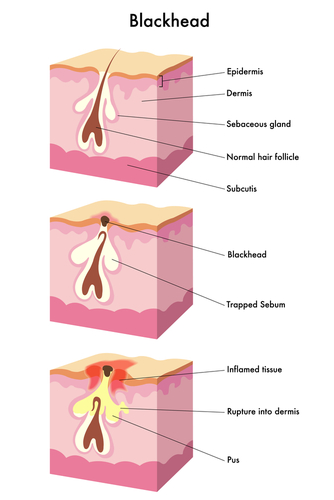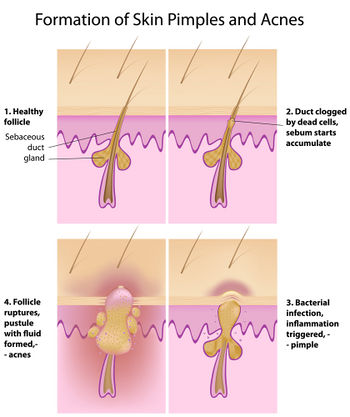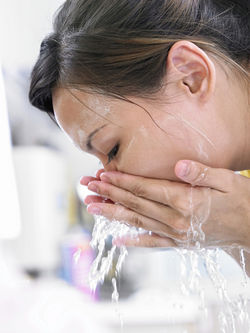Acne Vulgaris
Acne is a common chronic skin condition that affects both males and females in adolescence. For some, it can also continue into adulthood and it can affect women during pregnancy or during their menstrual cycle. Acne results in the development of pimples or pustules from blocked hair follicles and increased secretions in the sebaceous glands. Sebaceous glands produce sebum which is a mixture of oils and waxes. This sebum lubricates the skin and prevents water loss. Acne commonly appears on the face, upper back and upper arms and chest, as this is where there is the highest concentration of sebaceous glands.
|
Acne | |
| Causes | Dietary Factors, High Acidity, Stress, Environmental Chemicals |
|---|---|
| See Also | Skin Conditions, Hypochlorhydria, PMS |
| Books | Books on Skin Diseases such as The Clear Skin Diet and others. |
| Articles | Articles on Dermatology / Skin Conditions |
| Article | Case Study and Follow-Up of a 28-Year-Old Women with Acne Vulgaris, NDNR [1], 2011 May |
|---|
Naturopathic Assessment
| Article | Application of the Essential Oil from Copaiba (Copaifera langsdorffii Desf.) for Acne Vulgaris: a Double-Blind, Placebo-Controlled Clinical Trial , Alt Med; 2012;Vol17(1) |
|---|
| Check out this book | The Clear Skin Diet |
|---|
| Article | Case Study and Follow-Up of a 28-Year-Old Women with Acne Vulgaris, NDNR, 2011 May [2] |
|---|
The assessment of acne is typically done by inspection of the skin. The location of the acne can often indicate the cause or those factors that aggravate the acne. For example, acne that is worse or predominant on the back is more likely affected by high activity level when it causes acidic sweat.
Causal Factors
Skin is a primary route for the elimination of toxins. In order to stimulate the innate ability of the body to heal the causes of disease must be identified and addressed. With acne, the causes are variable and include lifestyle and environmental factors.
Lifestyle
- Food sensitivities can trigger or aggravate acne. The exact food triggers depends on a person's unique constitution.
- Diets high in chocolate, fatty foods or fast foods tend to increase acne flare-ups.
- Dairy products and high-glycemic-index foods have been found to influence hormonal and inflammatory factors, which can increase acne prevalence and severity.[1]
- Alcohol use may exacerbate acne.[2].
- Hygiene is primarily a concern when there is a pattern of over-washing or repetitive rubbing of the skin. This behaviour can weaken the integrity of the skin’s surface making a person more susceptible to acne.
- When a person is engaged in a high degree of activity, such as sports, and when the acne is worse in areas of increase sweating (chest and upper back) it is important to clean the skin thoroughly after each activity and before bed.
- Intense activity associated with acidic sweat can contribute to acne, especially on the back.
- Clothing that prevents evaporation of skin moisture can aggravate acne.
- Tight-fitting stretch garments such as "stretch bras," "stretch girdles" and "stretch socks." can irritate the skin and cause or worsen skin conditions such as lichen planus, psoriasis, acne vulgaris, discoid lupus erythematosus or atopic dermatitis.[3]
- The term acne mechanica designates local exacerbations due to pressure, friction, rubbing, squeezing, or stretching. The precipitating causes of stress are diverse, they include articles of clothing (tight straps and belts), recreational accouterments (football shoulder pads), or occupational pressure (rubbing of back in truck drivers).[4]
Social
Environmental
- Climate
- Humid conditions tend to make acne worse, probably due to increased sweating and the tendency for humidity to worsen inflammation.
External
- Household Products
- Bedding materials that don’t allow the skin to breathe.
- Some oil-based cosmetics or personal-care-products with petroleum-based chemicals or excipients and fillers that a person reacts to can contribute to acne.
Medical interventions
- Prescription Medications
- Prescription medication that alters hormone levels can aggravate acne. Other medications known to contribute include: corticosteroids, halogens and long-term use of antibiotics.
- Using inhaled corticosteroid drugs (as with COPD) may be implicated in acne and other skin manifestations [6].
Physiology
- Disruption in the elimination of toxins is a contributing factor to acne. For example, constipation contributes to the recycling of toxins in the body and when a person’s sweat is acidic it is more likely to contribute to acne.
Genetics
- Acne tends to run in families, yet it is often argued that the family link is not necessarily genetics, but food intolerances or nutritional deficiencies.
Common Assessment Questions
When assessing acne your naturopathic doctor will examine your skin and inquire about the following:
- When did the acne develop?
- Is it acute or chronic?
- What makes it better or worse?
- What are your hygiene habits?
- What other symptoms are associated with the acne?
- What impact does it have to your health and activities of daily living?
- What are your other health concerns?
Related Symptoms and Conditions
Other conditions associated with acne include:
- Hypochlorhydria
- Acne is often associated with increased levels of DHEA and the hormone testosterone. Although men have higher levels of testosterone than women, during puberty there is an increase of testosterone in both sexes.
- When the skin pores are blocked, bacteria can grow which further promotes inflammation and other skin disorders such as infectious folliculitis.
- Depression, anxiety and social withdrawal is common when acne is severe or does not respond to treatment.
Diagnostic Testing
- The diagnosis of acne is typically based on a visual assessment of the skin.
- For female patients with persistent acne blood measurements for testosterone, follicle-stimulating hormone, luteinizing hormone and dehydroepiandrosterone sulfate are often recommended.[7]
Characteristics
- Non-inflammatory lesions consist of comedones (blackheads and whiteheads). Blackheads are glands that get plugged with excessive material which discolours on exposure to air. Whiteheads are glands which have a small collection of pus.
- Inflammatory lesions consist of papules (pinheads) or pustules or pimples or nodules or large papules.
- Scarring is possible if chronic or severe
- Acne affects mostly skin with the densest population of sebaceous follicles, including the face, the upper part of the chest, and the back.
- Modified lipid pathways in the skin may be responsible for the increase in sebum secretion seen in acne [8].
Acne occurs in two forms:[9]
- Acne vulgaris: Also known as cystic acne affects the hair follicles and oil secreting glands of the skin and manifests as white-heads, black-heads, acne pimples, or blemishes.
- Acne conglobate: is a more severe form, manifest with deep cyst (nodules that fail to discharge pus at the surface) formations and subsequent scarring.
Naturopathic Treatment Strategy
The goal of naturopathic treatment is to support and work in tandem with the healing power of the body and to address the causal factors of disease with individual treatment strategies. Acne is considered both an acute and a chronic conditions.
It is always advisable to work with a naturopathic doctor before engaging in any treatment plan.
Home Care
Home Care strategies include:
- The first step of any treatment plan is to maintain a diary of symptoms tracking diet, activity level, stress and other outside influences that may be triggering a flare-up.
- Hygiene factors.
- Increase the frequency of bathing and ensure that the skin is cleaned especially after sweating or sports. But keep in mind, acne is not caused by dirt and cannot be washed away; it is an imbalance (whether hormonal or chemical) that needs to treated both topically and internally. When the acne is the most prevalent where a person sweats (upper back, between the breasts, arms etc) then washing after exertion is critical.
- Wash the face with warm water. Warm compresses are helpful to open and drain larger pustules
- Avoid touching the skin frequently or scrubbing too hard while washing.
- Avoid picking or popping acne lesions as this can lead to scarring.
- Clothing made from natural fibers (cotton, wool, linen, bamboo) allow the body to breathe and decrease the impact of sweat on the skin. This is also true of bedding materials and jackets.
- Personal Care Products. Avoid greasy creams or cosmetics and choose personal care products without chemicals or alcohol and ones that are hypoallergenic.
Lifestyle
Lifestyle recommendations include:
| Article | Back to the future: Acne vulgaris and nutrition, IHP, October 2009 |
|---|
- Avoid food allergies and food sensitivities. Address any nutrient deficiencies or dietary triggers.
- Eliminate refined and/or concentrated carbohydrates, sugars and chocolate. Decrease dairy products, eliminate trans fatty acids and high fat foods. An alkaline diet may also be recommended.[9]
- Choose hormone-free meats and fish. Avoid genetically modified foods.
- Water. Drink plenty of water to support the elimination of toxins from the body.
Naturopathic Therapies
The prescribing of naturopathic therapies requires the guidance of a naturopathic doctor as it depends on a number of factors including the causal factors, a person's age, prescription medications, other conditions and symptoms and overall health. It is always advisable to work with a naturopathic doctor prior to taking any natural therapies.
Naturopathic Therapies for acne vulgaris include:
- Clinical Nutritional Supplementation includes
- Vitamins such as Vitamin A, Vitamin C, Vitamin E, [9], Vitamin B5 or Pantothenic Acid, Vitamin B6, Niacin[10]
- Minerals such as Chromium, Selenium, Zinc,[9] Copper
- Other supplements such as Flax Seed Oil, Brewer's Yeast, [9] Lactobacilus acidophilus, Green Tea, Jojoba, Pregnenolone.
- Herbs such as[11], [12] Aloe (Aloe vera), Burdock (Arctium lappa), Calendula (Calendula officinalis), Chaste Tree (Vitex agnus-castus), Cranberry (Vaccinium macrocarpon), Goldenseal (Hydrastis canadensis), Tea Tree Oil (Melaleuca alternifolia), Echinacea (Echinacea angustifolia).
- Herbs with the following actions are often prescribed based on the specific characteristics of the acne outbreak: Alterative, Antimicrobial, Lymphatic, Hepatic, Diuretic, Anti-inflammatory other, Astringent.[13]
- Castor oil packs over the liver.
- Topical treatments include Tea Tree Oil, Calendula soap[9] and Neem tree soap.
- Steam-distilled volatile oil of Tea tree (Melaleuca alternifolia) leaf has been found to be effective in clearing acne comedone (blocked pore).[14]
- Diaphoretic herbs aid the skin in the elimination of toxins and promote perspiration.
- Bitter herbs to stimulate acid secretion, and herbs with antimicrobial, anti-inflammatory, anticomedogenic, and even hormone-balancing actions for acne treatment.[14]
- Gemmotherapies such as Equisetum arvense, Juglans regia, Platanus orientalis, Ribes nigrum, Rosmarinus officinalis
- Homeopathic remedies [15], [16] such as Calc Sulph, Hepar sulph, Nat mur, Kali brom, Pulsatilla, Sepia, Silica, Sulphur, Thuja. Other homeopathics prescribed for acne include Bellis, Belladonna, Eugenia jambosia, Berberis aquifolium, Antimonium crudum, Carbo animalis, Calcarea phos, Chrysarobinum, Carbo veg, Cimicifuga, Conium, Graphites, Juglans regia, Kali brom, Kali ars, Led pal, Oophorinum, Medorrhinum, Nux vomica, Acid phos, Psorinum, or Sulphuric acid.[17]
- Complex Homeopathy with a focus on liver drainage, cutaneous drainage, blood purification or symptom relief.
- Cell Salts: Sodium phosphate, Calcium sulphate
- Traditional Chinese Medicine & Acupuncture treatment considerations include: Clear and Drain Lung Heat, Clear Stomach Heat, Cool the Blood and Clear Heat, Clear Heat and Relieve Toxicity, or Eliminate Dampness and Relieve Toxicity, Invigorate Blood and Dispel Blood Stasis.[18]
- Acupuncture is beneficial in supporting detoxification and in aiding liver function.
References
Reviewed by Iva Lloyd, BScH, RPE, ND [3]
- ↑ Ferdowsian HR, Levin S (Mar 2010) Does diet really affect acne? Skin Therapy Lett.;15(3):1-2,5. PMID: 20361171.
- ↑ Kazakevich N, Moody MN, Landau JM, Goldberg LH (2011) Alcohol and skin disorders: with a focus on psoriasis. Skin Therapy Lett;16(4):5-6 PMID: 21611681
- ↑ Mihan R, Ayres S Jr (Feb 1968) Stretch garment dermatitis. Calif Med.;108(2):109-12. PMID: 5639939.
- ↑ Mills OH Jr, Kligman A (Apr 1975) Acne mechanica. Arch Dermatol.;111(4):481-3. PMID: 123732.
- ↑ Abad-Casintahan F, Chow SK, Goh CL et al. (Nov 2011) Toward evidence-based practice in acne: Consensus of an Asian Working Group. J Dermatol;V38(11):pp1041-8. ISSN: 03852407.
- ↑ Tashkin DP, Murray HE, Skeans M, Murray RP (2004) Skin manifestations of inhaled corticosteroids in COPD patients: results from Lung Health Study II. Chest Journal;126(4): 1123-1133 PMID:15486373
- ↑ Campbell James, Chapman Shane, Dinulos James, Zug Kathryn (2005) Skin Disease, Diagnosis and Treatment, Second Edition Elsevier Mosby
- ↑ Monica Ottaviani, Emanuela Camera, andMauro Picardo (2010) Lipid mediators in acne. Hindawi Publishing Corporation. PMID:20871834
- ↑ 9.0 9.1 9.2 9.3 9.4 9.5 Pizzorno Jr. Joseph E, Murray Michael T, Joiner-Bey Herb (2008) The Clinician's Handbook of Natural Medicine Churchill Livingstone Elsevier
- ↑ Surjana D, Damian DL (Nov-Dec 2011) Nicotinamide in dermatology and photoprotection. Skinmed.;9(6):360-5. PMID: 22256624.
- ↑ Godfrey Anthony, Saunders Paul Richard, Barlow Kerry, Gilbert Cyndi, Gowan Matthew, Smith Fraser 2010 Principles and Practices of Naturopathic Botanical Medicine, Vol 1: Botanical Medicine Monographs, CCNM Press, Toronto
- ↑ Boon Heather, Smith Michael 2004 The Complete Natural Medicine Guide to the 50 Most Common Medicinal Herbs, Robert Rose, Toronto
- ↑ Hoffman D (2003) Medical Herbalism: The Science Principles and Practices Of Herbal Medicine. Healing Arts Press.
- ↑ 14.0 14.1 Yarnell E, Abascal K (Dec 2006) Herbal medicine for acne vulgaris. Altern Complement Ther.;12(6):303-309.
- ↑ Hershoff Asa 2000 Homeopathic Remedies, A Quick and Easy Guide to Common Disorders and their Homeopathic Treatments, Avery Publishing Group, New York
- ↑ Ullman Robert, Reichenberg-Ullman Judyth (1997) Homeopathic Self-Care, the quick and easy guide for the whole family. Prima Publishing
- ↑ Master FJ (1993) Diseases Of The Skin Including The Exanthemata. B. Jain Publishers Pvt. Ltd.
- ↑ De-Hui S, Xiu-Fen W, Wang N (1995) Manual of Dermatology in Chinese Medicine. Eastland Press.



